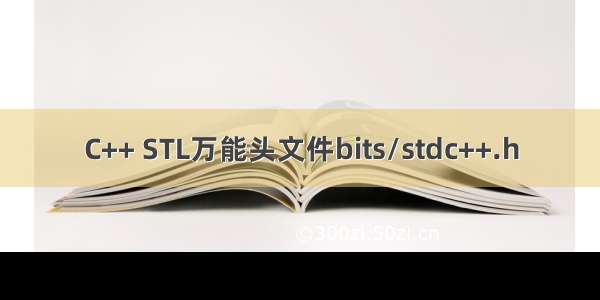
文章目录
前言基本用法内容优点和缺点优点缺点适用环境前言
最近学了几节c++编程课,发现老师经常在代码第一行敲上一句:
#include <bits/c++std.h>
后来知道它原来是所谓的 “万能头文件”。
今天,我就给大家讲解一下它的用法和优缺点。
基本用法
#include <bits/stdc++.h>using namespace std;int main() {//在此处写代码}
内容
// C++ includes used for precompiling -*- C++ -*-// Copyright (C) - Free Software Foundation, Inc.//// This file is part of the GNU ISO C++ Library. This library is free// software; you can redistribute it and/or modify it under the// terms of the GNU General Public License as published by the// Free Software Foundation; either version 3, or (at your option)// any later version.// This library is distributed in the hope that it will be useful,// but WITHOUT ANY WARRANTY; without even the implied warranty of// MERCHANTABILITY or FITNESS FOR A PARTICULAR PURPOSE. See the// GNU General Public License for more details.// Under Section 7 of GPL version 3, you are granted additional// permissions described in the GCC Runtime Library Exception, version// 3.1, as published by the Free Software Foundation.// You should have received a copy of the GNU General Public License and// a copy of the GCC Runtime Library Exception along with this program;// see the files COPYING3 and COPYING.RUNTIME respectively. If not, see// <Licenses - GNU Project - Free Software Foundation>./** @file stdc++.h* This is an implementation file for a precompiled header.*/// 17.4.1.2 Headers// C#ifndef _GLIBCXX_NO_ASSERT#include <cassert>#endif#include <cctype>#include <cerrno>#include <cfloat>#include <ciso646>#include <climits>#include <clocale>#include <cmath>#include <csetjmp>#include <csignal>#include <cstdarg>#include <cstddef>#include <cstdio>#include <cstdlib>#include <cstring>#include <ctime>#if __cplusplus >= 03L#include <ccomplex>#include <cfenv>#include <cinttypes>#include <cstdalign>#include <cstdbool>#include <cstdint>#include <ctgmath>#include <cwchar>#include <cwctype>#endif// C++#include <algorithm>#include <bitset>#include <complex>#include <deque>#include <exception>#include <fstream>#include <functional>#include <iomanip>#include <ios>#include <iosfwd>#include <iostream>#include <istream>#include <iterator>#include <limits>#include <list>#include <locale>#include <map>#include <memory>#include <new>#include <numeric>#include <ostream>#include <queue>#include <set>#include <sstream>#include <stack>#include <stdexcept>#include <streambuf>#include <string>#include <typeinfo>#include <utility>#include <valarray>#include <vector>#if __cplusplus >= 03L#include <array>#include <atomic>#include <chrono>#include <condition_variable>#include <forward_list>#include <future>#include <initializer_list>#include <mutex>#include <random>#include <ratio>#include <regex>#include <scoped_allocator>#include <system_error>#include <thread>#include <tuple>#include <typeindex>#include <type_traits>#include <unordered_map>#include <unordered_set>#endif
包含了一大堆头文件,省下了写那么多头文件的时间。在有时限的竞赛中,往往可以用到。
优点和缺点
说了那么多,那么它真的是所有C++程序员们梦寐以求的 “万能头文件”吗?
















